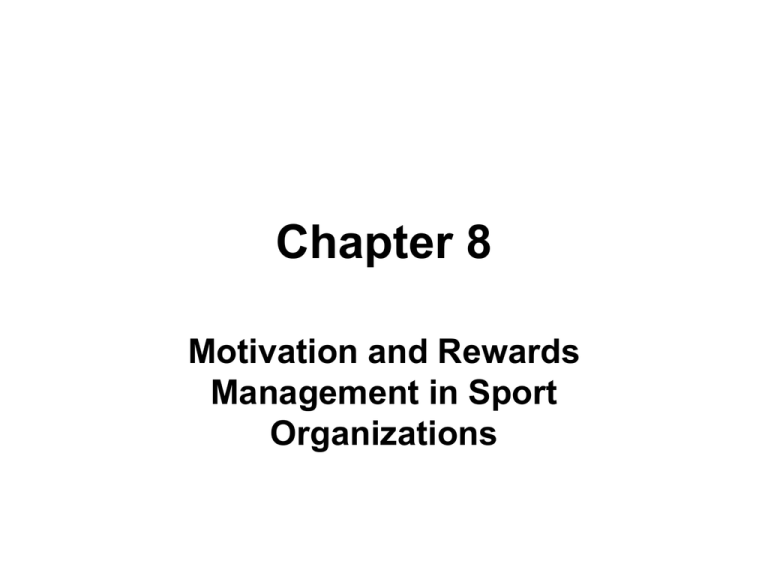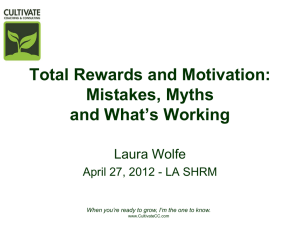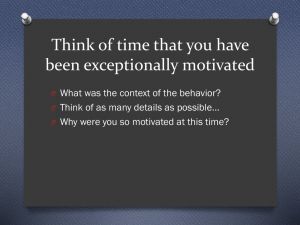Chapter 8 - Routledge
advertisement

Chapter 8 Motivation and Rewards Management in Sport Organizations Learning objectives – Explain the role of rewards in employee and volunteer motivation – Describe different types of intrinsic and extrinsic rewards – Describe the components of a financial compensation plan – Recognize job design as part of a rewards management system – Understand the importance of volunteer recognition Rewards management • to attract, motivate and retain employees and volunteers • reward strategies should support an organisation’s goals and its human resource plan • selection and design of an effective rewards management system should consider human motivation theories Theories of motivation • motivation is a psychological state that describes one’s drive to engage in a particular behaviour • Content theories and Process theories are used to understand motivation Content theories • attempt to explain what motivates individuals • The 3 classic theories are: 1. Maslow’s hierarchy of needs theory 2. Herzberg’s motivator-hygiene theory 3. McLelland’s three needs theory Maslow’s hierarchy of needs Based on 5 progressive levels of needs that every human experiences: • Physiological needs (e.g., food, shelter, clothing) • Safety needs (e.g., security, stability, health) • Belongingness needs (e.g., affection, acceptance, friendship) • Esteem needs (e.g., self-esteem, confidence, respect by others) • Self-actualization (e.g., personal growth, morality) Herzberg’s motivator-hygiene theory • aspects of the job itself (work content) related to satisfaction; eg, achievement, recognition – ‘motivators’ • aspects of the workplace (work context) related to dissatisfaction; eg, policies, relationship with supervisor – ‘hygienes’ • Improvement of hygiene factors is needed to avoid employee dissatisfaction • to increase motivation opportunities for employee achievement, recognition, and growth (motivators) must be addressed McLelland’s 3 need theory • Need for achievement –to accomplish moderately challenging performance goals, be successful in competitive situations, assume personal responsibility for work (rather than delegating it to others) • Need for power –to control one’s environment, including people and material resources. • Need for affiliation –to seek approval from others, conform to their wishes and expectations, and avoid conflict/confrontation • individuals have some need for achievement, power and affiliation, however, one of these needs will be predominant Process theories • explain how individuals are motivated; that is, the cognitive process that individuals go through that explain how a felt need can result in certain behaviour • Two classic process theories are equity theory and expectancy theory Equity theory • extends the content theories of motivation by proposing that individuals will be motivated, not just by a given reward, but by whether they perceive the reward situation to be equitable and fair • individuals will evaluate a given reward according to whether they feel it is proportionate with their own efforts & whether it is equitable to the efforts and rewards of others Classic model of equity • ‘people will evaluate the fairness of their situation in an organisation based on a comparison of the ratio of their own inputs and outcomes with some referent’s ratio of inputs and outcomes’ (Mitchell & Daniels, 2003, p. 242) • When the ratios are unequal individuals are motivated to rectify the perceived inequity by (a) modifying their own input (effort) to outcome (rewards) ratio, (b) changing their referent other and focusing instead on another person’s ratio of inputs and outcomes, (c) distorting their perceptions, or (d) quitting Expectancy theory • describes the cognitive process individuals go through when determining whether to exert effort • assumes that individuals are rational beings who think about possible outcomes before they engage in behaviour • motivation to exert effort is a function of an individual’s perception that, engagement in a particular behaviour (e.g., performs tasks well) will be acceptable and rewarded – and the reward is valued Types of rewards • Intrinsic rewards - received directly as a result of performing his or her job • presume that there can be value in the task itself • Extrinsic rewards - financial (salary or wages, incentives or bonuses) or nonfinancial (pension contributions, life insurance) Financial compensation plan • objectives should be clearly stated & consistent with its corporate strategy and human resource plan. • What does the sport organization want to pay for? What does it want to reward? • the objectives form the basis upon which pay and incentives will be awarded Pay structure Three principles guide the establishment of a pay structure: 1. internal equity 2. the external market 3. employee contribution Internal equity • (a) comparable pay for comparable content of work • (b) comparable skills that are required • (c) comparable contribution of the work or skills to the objectives of an organisation External market principle • refers to positioning an organisation’s pay structure, relative to what competitors are paying • needs to be considered in setting a competitive (and equitable) compensation package in order to attract and retain competent staff Employee contribution Refers to the relative emphasis in a pay structure on compensation by 1. job level 2. skills 3. seniority 4. performance • or some combination. Factors Major league teams Major league offices College/ University athletics Sport marketing agencies Minor league teams Arenas/spor t venues Broadcast/ media Average compensation ($US) $79,560 $77,500 $44,930 $103,077 $50,698 $63,684 $118,269 Range of compensation $25,000350,000 $25,000312,500 $25,00085,000 $25,000350,000 $25,000337,500 $27,500162,500 $27,500350,000 % compensation based on bonus/commission 12.3% 13.9% 2.5% 19.7% 18.0% 4.7% 23.5% Bonuses based on dept. performance 45.7% 37.2% 58.3% 18.5% 8.6% 37.8% 35.6% Bonuses based on company performance 24.0% 20.6% 16.7% 47.2% 61.4% 23.3% 30.6% Bonuses based on individual performance 28.6% 42.2% 25.0% 34.3% 30.0% 38.9% 33.8% Entertainment expense account 54% 41% 28% 58% 32% 53% 77% Pension 56% 59% 75% 33% 11% 68% 54% Company car/auto reimbursement 42% 32% 61% 35% 32% 37% 25% Tuition reimbursement 13% 5% 64% 6% 3% 3% 25% Country club membership 10% 0% 11% 4% 12% 11% 6% Data is based on a survey of 421 sport marketing professionals employed in seven segments of the sport industry in the United States. Respondents were predominantly male (81.6%), average age 35.5 years, holding an undergraduate degree (94%), with an average of 8.8 years of experience in the sport industry, and a 57-hour average work week. Job design • the opportunity to fulfill individual needs can be built into the design of a job • typical motivating elements of a job are: autonomy, intrinsic job feedback, extrinsic job feedback, social interaction, task variety, task identity, skill/knowledge requirements, task significance, growth/learning, and recognition Hackman & Oldham’s job characteristics model Five core job characteristics: 1. skill variety 2. task identity 3. task significance 4. task autonomy 5. job feedback – contribute to employees’ sense of the meaningfulness of their work, responsibility for the outcomes of their work, and knowledge of the results of their work Volunteer recognition & rewards (a) normative incentives - motivated by the opportunity to help a cause such as a sport program which he or she may feel is important (b) affective incentives - motivated by the opportunity to work with others, develop friendships, and identify with a group (c) utilitarian incentives - motivated by the opportunity to use skills or sport background to develop new skills and work experience or to network in the community • the importance of these incentives varies by sport volunteers’ age Nonfinancial extrinsic rewards • can be an important symbolic expression of appreciation for contributions and performance • provide some kind of alternative recognition that is tangible and extrinsic to the act of volunteering itself eg letter or thanks, award for service, complimentary tickets to special events and functions etc. Summary • Content theories (e.g., Maslow’s Hierarchy of Needs Theory, Herzberg’s Motivator-Hygiene Theory, McClelland’s Three-Need Theory) explain what motivates employees and volunteers, while process theories (e.g., equity theory, expectancy theory) explain how they are motivated. • Job design can be used to increase the motivating potential of a job by increasing task variety, task identity, task significance, autonomy, and direct feedback, all of which provide an employee or volunteer with an increased sense of the meaningfulness of their job, responsibility for the outcomes of their work, and knowledge of results of their contributions. • Volunteers by definition do not receive extrinsic (direct) financial compensation, therefore the sport organisation must rely on the intrinsic rewards of the volunteer role itself to ensure their needs are met.





